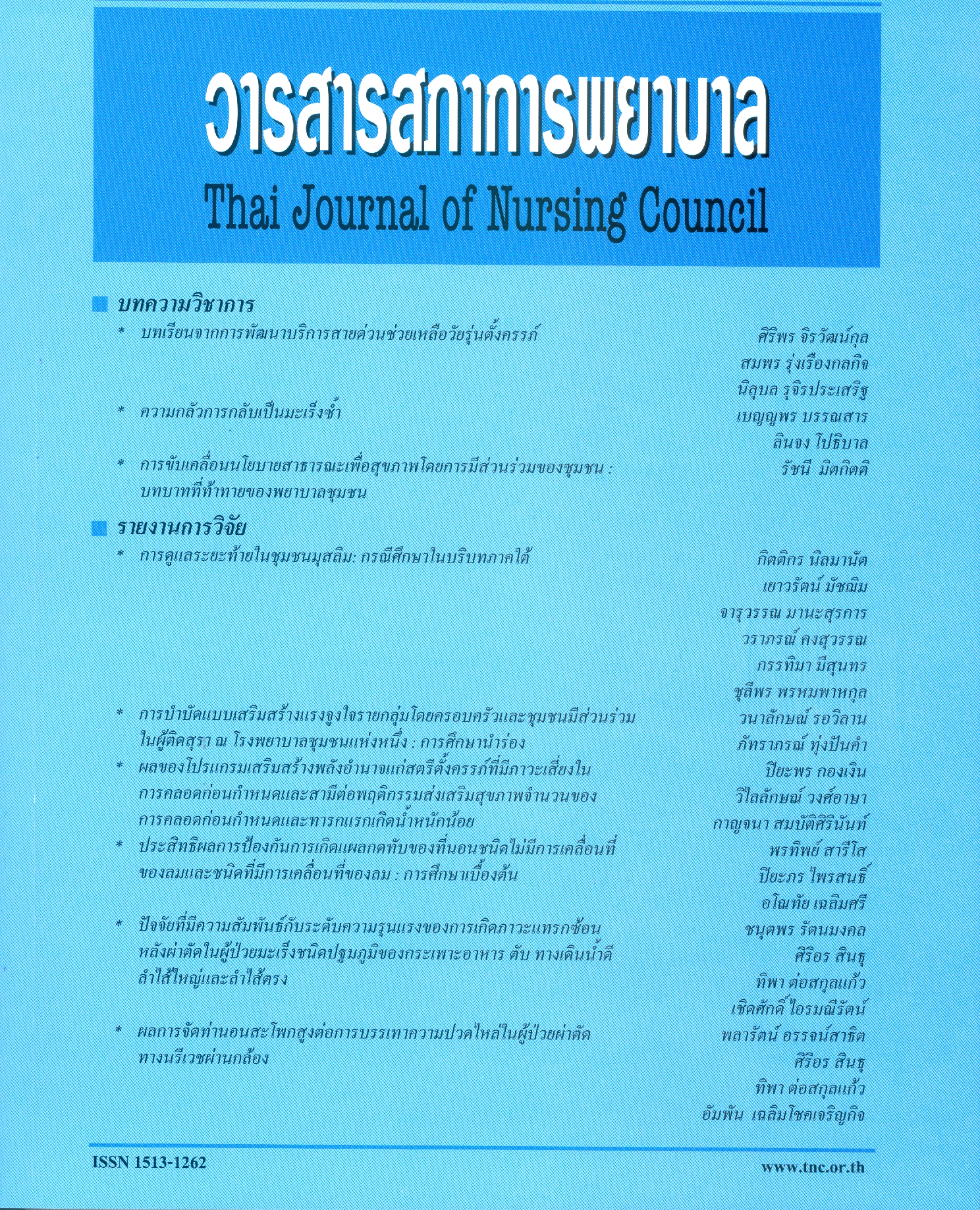ผลการจัดท่านอนสะโพกสูงต่อการบรรเทาความปวดไหล่ในผู้ป่วยผ่าตัด ทางนรีเวชผ่านกล้อง
Keywords:
การจัดท่านอนสะโพกสูง, การบรรเทาอาการปวดไหล่, การผ่าตัดทางนรีเวชผ่านกล้อง, hip-up position, shoulder pain relief, female laparoscopic surgery patientsAbstract
Objective: To study the positive effect of a hip-up position on the
relief of shoulder pain in female laparoscopic surgery patients.
Design: Randomised controlled trial.
Procedure: The study was conducted on a sample of 50 female
laparoscopic surgery patients in both the standard and
special gynaecology wards of a hospital in
Bangkok, from October 2014 to April 2015.
Data were collected during the frst 24 hours after
each patient’s operation. The research instruments consisted of
(1) a personal and illness information form;
(2) a surgery record form; and
(3) a pain assessment form. The data were analysed using T-test statistics.
Results: Before the administration of the hip-up method,
the experimental and control groups had average
shoulder pain scores of 3.62 and 3.96, respectively. A
T-test-based comparison showed the difference to be statistically
insignifcant (p > 0.05). After the administration of
the hip-up method, on the other hand, the experimental
group’s average shoulder pain score was 0.72,
whilst the control group’s was 2.29.
A T-test-based comparison showed the difference to be
statistically signifcant (0.05;p = 0.00).
Recommendations: It is suggested that the hip-up position be applied to female
laparoscopic surgery patients with a shoulder pain level of higher than 3. Effectively reducing
shoulder pain, this hip-up method is a practical alternative for this group of patients.
ปวดไหล่ในผู้ป่วยผ่าตัดทางนรีเวชผ่านกล้อง
การออกแบบวิจัย: การวิจัยเชิงทดลองแบบสุ่มและมีกลุ่มควบคุม (randomized
controlled trial)
การดำเนินการวิจัย: กลุ่มตัวอย่างคือผู้ป่วยผ่าตัดทางนรีเวชผ่านกล้อง จำนวน 50 ราย
เก็บข้อมูลที่หอผู้ป่วยนรีเวชทั้งสามัญและพิเศษ โรงพยาบาลศิริราชตั้งแต่หลังผ่าตัดจนครบ
24 ชั่วโมงหลังผ่าตัดระหว่างเดือนตุลาคม 2557 ถึงเดือนเมษายน 2558 เครื่องมือวิจัย
ประกอบด้วยแบบสอบถามข้อมูลส่วนบุคคลและข้อมูลความเจ็บป่วย แบบบันทึกข้อมูล
การผ่าตัดและแบบประเมินอาการปวด วิเคราะห์ข้อมูลโดยใช้สถิติ t - test
ผลการวิจัย: อาการปวดไหล่หลังทำากิจกรรมการพยาบาล พบว่า ในกลุ่มทดลองมี
ระดับอาการปวดไหล่เฉลี่ย 0.72 คะแนน และในกลุ่มควบคุมมีระดับอาการปวดไหล่เฉลี่ย
2.29 คะแนน เมื่อนำาทั้งสองกลุ่มมาเปรียบเทียบโดยใช้สถิติ t - test พบว่า แตกต่างกัน
อย่างมีนัยสำาคัญทางสถิติที่ระดับ <.001
ข้อเสนอแนะ: การจัดท่านอนสะโพกสูงใช้สำาหรับการดูแลผู้ป่วยหลังผ่าตัดผ่านกล้อง
กลุ่มผู้ป่วยนรีเวชที่มีระดับอาการปวดไหล่มากกว่า 3 คะแนน สามารถลดระดับคะแนน
อาการปวดไหล่ได้ จึงเป็นอีกทางเลือกหนึ่งในการลดอาการปวดไหล่สำาหรับผู้ป่วยกลุ่มนี้








